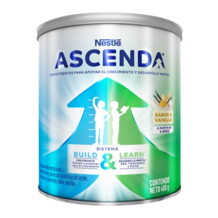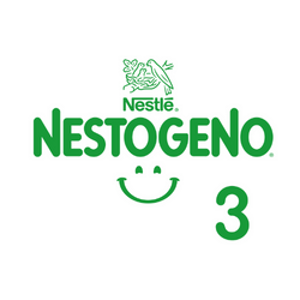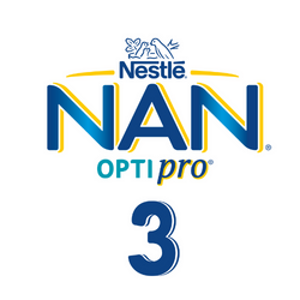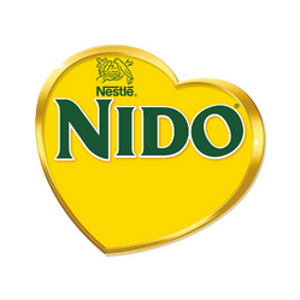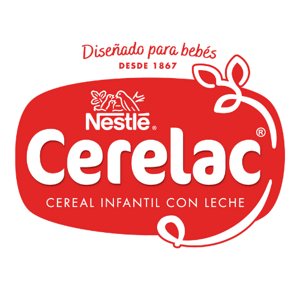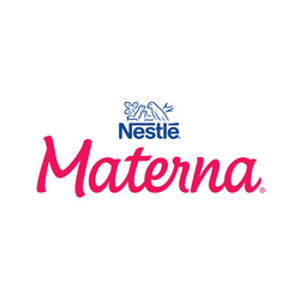¡Llegó ASCENDA® de Nestlé®!
¿Tu hijo no está ganando el peso y talla que necesita?
Nestle® te ofrece ASCENDA®
Un complemento alimenticio denso de energía y nutrientes diseñado para apoyar el crecimiento físico de tu hijo.
Su exclusivo sistema Build & Learn está desarrollado con nutrientes que apoyan tanto el crecimiento físico, como el desarrollo del cerebro.

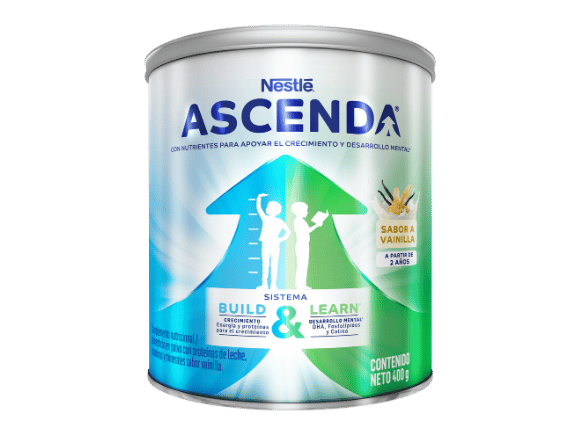
IDENTIFICA LOS SIGNOS DE UN CRECIMIENTO DEFICIENTE
Un crecimiento normal o saludable en relación con los estándares de crecimiento de acuerdo a la edad, casi siempre, es el resultado de una buena salud en los niños..
El crecimiento deficiente es cuando tu hijo se está quedando atrás en la curva de crecimiento normal.
PERO EL CRECIMIENTO DEFICIENTE NO SOLO AFECTA EL PESO Y LA ALTURA, SINO QUE TAMBIÉN AFECTA EL DESARROLLO DE SU CEREBRO.

DADO QUE EL 90% DEL DESARROLLO DEL CEREBRO OCURRE EN LA PRIMERA INFANCIA, ES ESENCIAL QUE OBTENGA LA AYUDA NUTRICIONAL ADECUADA PARA APOYAR SU APRENDIZAJE, COMPORTAMIENTO Y SALUD.
¿Cuáles son las consecuencias de un crecimiento deficiente?
¿COMER DE FORMA SELECTIVA PUEDE SER UN SIGNO?

Comer de forma selectiva es un comportamiento común en la temprana edad:
![]() Falta de voluntad para probar nuevos alimentos o diferentes a los habituales..
Falta de voluntad para probar nuevos alimentos o diferentes a los habituales..
![]() Fuertes preferencias alimentarias.
Fuertes preferencias alimentarias.
Valida con el pediatra que este comportamiento no impacte los requisitos nutricionales de tu hijo.
¿CÓMO RETOMAR LA CURVA DE CRECIMIENTO FÍSICO DE TU HIJO?
Presentamos ASCENDA® de Nestlé®
Un complemento alimenticio denso en energía y nutrientes para

AYUDAR A POTENCIAR SU CRECIMIENTO FÍSICO
Energía y proteína
Valores clínicamente demostrados para aumentar el peso y la altura en los niños que se retrasan en su curva de crecimiento.¹⁻⁶
Con Hierro, Zinc y Vitamina A
Nutrientes claves que apoyan la recuperación del crecimiento en niños nutricionalmente en riesgo.⁷⁻⁹
Además apoyan la función normal muscular, ósea y del sistema inmune.⁷⁻⁹
Zinc, ayuda a reestablecer el apetito.¹⁰
100% proteína láctea
Contiene proteína de suero de leche de alta calidad enriquecida con alfa-lactoalbúmina que es fácil de digerir y absorber.¹¹
Proporciona todos los aminoácidos esenciales.¹¹

APOYAR SU APRENDIZAJE
DHA y fosfolípidos incluido esfingomielina.
Componentes estructurales importantes para procesos críticos del desarrollo del cerebro.¹²⁻¹⁸
Fuente de Colina, Hierro, Zinc y Yodo
Con Colina, Hierro, Zinc, Yodo, Vitamina A, y Luteína que apoyan la memoria cognitiva y el desarrollo visual.¹⁹⁻²⁵
Estos nutrientes apoyan áreas de desarrollo que están relacionadas con el aprendizaje.¹²⁻²⁵
*Las habilidades derivadas del desarrollo mental como el aprendizaje dependen de diversos factores.
Conoce más de Nestlé® ASCENDA®

ARTÍCULOS
RECETAS

Paleta de fresas con ASCENDA®
Refrescantes paletas de fresas con el complemento alimenticio ASCENDA®. Un snack ideal y nutritivo para compartir en familia.

Arepas con ASCENDA®
Prepara unas arepas esponjosas y saludables con el complemento alimenticio ASCENDA®. Listas en 10 minutos y perfectas para un desayuno lleno de energía.

Pie de Limón con ASCENDA®
Deléitate con un pie de limón cremoso y nutritivo con el complemento alimenticio ASCENDA®. Perfecto para una porción rápida y refrescante.

Cupcake de Moras con ASCENDA®
Disfruta de cupcakes de moras esponjosos y nutritivos con ASCENDA®, ideales para una merienda saludable y rápida.

Galletas de Arándanos con ASCENDA®
Disfruta de galletas de arándanos con un toque nutritivo de ASCENDA®, ideales para una merienda deliciosa y saludable.

Pastel de Zanahoria con ASCENDA®
Deléitate con este pastel de zanahoria esponjoso, enriquecido con ASCENDA®. Ideal para una merienda rápida y saludable, listo en minutos.

Desayuno Nutritivo de Brócoli con ASCENDA®
Inicia tu día con este desayuno de brócoli, avena y queso. Rico en nutrientes y sencillo de preparar, ideal para una mañana saludable.

Pudin de Avena Nutritivo con ASCENDA®
Disfruta de un pudin de avena saludable y delicioso. Con banano, yogurt y ASCENDA® de Nestlé®, es perfecto para empezar el día con energía.

Crema de Maíz con ASCENDA®
Prueba esta crema de maíz con ASCENDA® de Nestlé®, ideal para una comida nutritiva y fácil de hacer en solo 25 minutos.

Pollo a la Cremosa con ASCENDA®
Disfruta de esta receta de pollo cremoso con ASCENDA® de Nestlé®, perfecta para un almuerzo nutritivo y fácil de preparar.

Mousse de Chocolate con ASCENDA®
Este mousse de chocolate es cremoso, delicioso y saludable, preparado con ASCENDA® de Nestlé® y listo en solo 30 minutos.
Preguntas Frecuentes
¿QUÉ SON LOS COMPLEMENTOS ALIMENTICIOS?
El complemento alimenticio es un alimento que busca complementar la ingesta de nutrientes en la alimentación diaria, especialmente para personas con consumo limitado de alimentos. Por ello, el complemento alimenticio ASCENDA® de Nestlé® puede ser consumido por niños en crecimiento.
¿CUAL ES LA DIFERENCIA ENTRE EL COMPLEMENTO ALIMENTICIO Y LAS
LECHES DE CRECIMIENTO?
Los alimentos lácteos comúnmente llamados leches de Crecimiento, son alimentos que cuentan con constituyentes de origen animal y/o vegetal y pueden contener vitaminas y minerales (corno hierro, zinc, vitamina A, DHA, omegas), prebióticos y/o probióticos. Estos comúnmente son indicados en sustitución de la leche de vaca por su elaborada composición para satisfacer las necesidades nutricionales de un niño sano y en desarrollo (que muestren una ganancia de peso y altura adecuada para la edad).
En cambio, un complemento alimenticio infantil como ASCENDA®, en comparación con los alimentos lácteos de crecimiento, ofrece concentraciones más altas de macronutrientes (principalmente proteína) y
micronutrientes (vitamina y minerales) para complementar una dieta desequilibrada, permitiendo que sea apto para niños que presentan algún retraso en su crecimiento debido a la falta de nutrientes.
Se debe considerar el uso de complementos alimenticios para pacientes con dificultades alimentarios ya que han demostrado, científicamente, ser una opción efectiva para garantizar la seguridad nutricional de estos niños.
¿PUEDO DILUIR ASCENDA® EN LECHE DE VACA Y/O COMPUESTO LÁCTEO?
No, ASCENDA® es un complemento alimenticio que debe diluirse en agua.
¿ASCENDA® REEMPLAZA UNA COMIDA (ALMUERZO/CENA)?
ASCENDA® no sustituye una comida ya que su finalidad es complementar la ingesta de nutrientes en
la dieta de los niños. Por lo que, es importante seguir motivándolos a consumir sus tiempos de comida
(como desayuno, almuerzo y cena) para apoyarles con el desarrollo de hábitos saludables de alimentación.
¿CÓM0 PUEDO DIVERSIFICAR EL USO DE ASCENDA®?
ASCENDA® se puede consumir solo como complemento a la dieta, o también, para ofrecer variedad a los niños, puede combinarse con recetas.
Te mostraremos algunas ideas con ASCENDA® para que puedas disfrutar con tu niño y a la vez complementar su dieta con macro y micronutrientes claves que le ayudarán no solo a potenciar su crecimiento, sino que también apoyarán su aprendizaje*.
+Las habilidades derivadas del desarrollo mental, como el aprendizaje, dependen de diveros factores.
Referências Bibliográficas:
1. Conforme composição e tabela nutricional do produto e comparativo de mercado realizado em set/2021.
2. Crookston BT, Penny ME, Alder SC, et al. Children who recover from early stunting and children who are not stunted demonstrate similar levels of cognition. J Nutr. 2010;140(11):1996-2001.
3. Sheng X, Tong M, Zhao D, et al. Randomized controlled trial to compare growth parameters and nutrient adequacy in children with picky eating behaviors who received nutritional counseling with or without an oral nutritional supplement. Nutr Metab Insights. 2014;7:NMI-S15097.
4. Huynh DT, Estorninos E, Capeding RZ, Oliver JS, Low YL, Rosales FJ. Longitudinal growth and health outcomes in nutritionally at-risk children who received long-term nutritional intervention. J Hum Nutr Diet. 2015;28(6):623-35.
5. Alarcon PA, Lin LH, Noche Jr M, et al. Effect of oral supplementation on catch-up growth in picky eaters. Clin Pediatr. 2003;42(3):209-17.
6. Rivera JA, Hotz C, González-Cossío T, Neufeld N, García-Guerra A. The Effect of Micronutrient Deficiencies on Child Growth: A Review of Results from Community-Based Supplementation Trials. J Nutr. 2003;133(11):4010S-20S.
7. Brown KH, Peerson JM, Rivera J, Allen LH. Effect of supplemental zinc on the growth and serum zinc concentrations of prepubertal children: a meta-analysis of randomized controlled trials. Am J Clin Nutr. 2002;75(6):1062-71.
8. Low M, Farrell A, Biggs BA, Pasricha SR. Effects of daily iron supplementation in primary-school-aged children: systematic review and meta-analysis of randomized controlled trials. CMAJ. 2013;185(17):E791-802.
9. Deoni S, Dean D 3rd, Joelson S, O'Regan J, Schneider N. Early nutrition influences developmental myelination and cognition in infants and young children. Neuroimage. 2017;178:649-659.
10. Georgieff MK. Nutrition and the developing brain: nutrient properties and measurement. Am J Clin Nutr. 2007;85(2):614S-20S.
11. Lauritzen L, Brambilla P, Mazzocchi A, Harsløf LB, Ciappolino V, Agostoni C. DHA Effects in Brain Development and Function. Nutrients. 2016;8(1):1-17.
12. Martínez M, Mougan I. Fatty acid composition of human brain phospholipids during normal development. J Neurochem. 1998;71(6):2528-33.
13. Schmitt S, Castelvetri LC, Simons M. Metabolism and functions of lipids in myelin. Biochim Biophys Acta Mol Cell Biol Lipids. 2015;1851(8):999-1005.
14. Zheng L, Fleith M, Giuffrida F, O’Neill BV, Schneider N. Dietary Polar Lipids and Cognitive Development: A Narrative Review. Adv Nutr. 2019;10(6):1163-76.
15. Lozoff B. Early iron deficiency has brain and behavior effects consistent with dopaminergic dysfunction. J Nutr. 2011;141(4):740S-6S.
16. Zeisel SH. Choline: needed for normal development of memory. J Am Coll Nutr. 2000;19(5 Suppl):528S-31S.
17. Prado EL, Dewey KG. Nutrition and brain development in early life. Nutr Rev. 2014;72(4):267-84.
18. Delange F. The role of iodine in brain development. Proc Nutr Soc. 2000;59(1):75-9.
19. Gower-Winter SD, Levenson CW. Zinc in the central nervous system: From molecules to behavior. BioFactors. 2012;38(3):186-93.
20. Solomons NW. Vitamin A. In: Present Knowledge in Nutrition. 9th ed. Washington, DC: International Life Sciences Institute;2006:157-83.
21. Ames BN. Prolonging healthy aging: Longevity vitamins and proteins. Proc Natl Acad Sci USA. 2018;115(43):10836-44.
22. ILSI. Funções plenamente reconhecidas. Força tarefa de alimentos fortificados e suplementos. 2ª edição, 2017-2018. Disponível em: https://ilsi.org/publication/funcoes-plenamente-reconhecidas/ [acessado em Nov/ 2020].
23. Cozzolino, SMF. Biodisponibilidade de Nutrientes. São Paulo: 2005.
24. ILSI. Micronutrientes nos primeiros 6 anos de vida -Força-tarefa de nutrição da criança. São Paulo: ILSI Brasil, 2019.
25. Alarcon PA, Lung-Huang L, Noche M Jr, et al. Effect of oral supplementation on catch-up growth in picky eaters. Clin Pediatr. 2003;42(3):209-17.
26. Ghosh AK, Kishore B, Shaikh I, et al. Effect of oral nutritional supplementation on growth and recurrent upper respiratory tract infections in picky eating children at nutritional risk: a randomized, controlled trial. J Int Med Res. 2018;46(6):2186-201.
27. Ghosh AK, Kishore B, Shaikh I, et al. Continuation of oral nutritional supplementation supports continued growth in nutritionally at-risk children with picky eating behaviour: A post-intervention, observational follow-up study. J Int Med Res. 2018;46(7):2615-632.
28. Huynh DT, Estorninos E, Capeding RZ, Oliver JS, Low YL, Rosales FJ. Longitudinal growth and health outcomes in nutritionally at-risk children who received long-term nutritional intervention. J Hum Nutr Diet. 2015;28(6):623-35.
29. Huynh DT, Estorninos E, Capeding MR, Oliver JS, Low YL, Rosales FJ. Impact of long-term use of oral nutritional supplement on nutritional adequacy, dietary diversity, food intake and growth of Filipino preschool children. J Nutr Sci. 2016;5(20):1-11.
30. Shay NF and Mangian HF, Neurobiology of Zinc-Influenced Eating Behavior. J. Nutr. 130: 1493S—1499S, 2000.
31. McGregor RA, Poppitt SD. Milk protein for improved metabolic health: a review of the evidence. Nutr Metab (Lond). 2013;10(1):46.
32. Mølgaard C et al. Milk and Growth in Children: Effects of Whey and Casein. Nestlé Nutr Inst Workshop Ser Pediatr Program, 2011, vol 67, pp 67–78.
33. Mathai JK, Liu Y and Stein HH. Values for digestible indispensable amino acid scores (DIAAS) for some dairy and plant proteins may better describe protein quality than values calculated using the concept for protein digestibility-corrected amino acid scores (PDCAAS). British Journal of Nutrition (2017), 117, 490–9.
34. ILSI. Funções plenamente reconhecidas de nutrientes. Proteínas (vol 20). Força tarefa alimentos fortificados e suplementos. 2ª ed., 2019. Disponível em: http://ilsibrasil.org/wp-content/uploads/sites/9/2020/06/Fasc%C3%ADculo… [acessado em julho/2021].
35. ILSI. Funções plenamente reconhecidas de nutrientes. Fibra alimentar (vol 18). Força tarefa alimentos fortificados e suplementos. 2ª ed., 2017. Disponível em: http://ilsibrasil.org/wp-content/uploads/sites/9/2018/10/Fasc%C3%ADculo… [acessado em maio/2021].
36. SBP. Temas da atualidade em nutrologia pediátrica. Sociedade Brasileira de Pediatria. Dpto Científico de Nutrologia. São Paulo: 2021.
37. Wegh CAM, Schotermanc MHC, Vaughand EE et al. The effect of fiber and prebiotics on children´s gastrointestinal disorders and microbiome. Expert Review of Gastroenterology & Hepatology, 2017;11(7–12), 1031-45.
38. Gibson GR, Hutkins R, Sanders ME et al. The International Scientific Association for Probiotics and Prebiotics (ISAPP) consensus statement on the definition and scope of prebiotics. Nat Rev Gastroenterol Hepatol. 2017 Aug;14(8):491-502.
39. WHO. Guideline: sugars intake for adults and children. Geneva: World Health Organization: 2015.
40. Fidler Mis N, Braeggar C, Bronsky J, et al. Sugar in Infants, Children and Adolescents: A Position Paper of the European Society for Paediatric Gastroenterology, Hepatology and Nutrition. J Pediatr Gastroenterol Nutr. 2017;65(6):681-96
41. National Research Council (US) and Institute of Medicine Committee (US) on Integrating the Science of Early Childhood Development. Shonkoff JP, Phillips D, eds. From Neurons to Neighborhoods: The Science of Early Childhood Development. National Academy Press; 2000.
42. Laus MF, Vales LD, Costa TM, Almeida SS. Early postnatal protein-calorie malnutrition and cognition: a review of human and animal studies. Int J Environ Res Public Health. 2011;8(2):590-612.
43. Uauy R, Dangour AD. Nutrition in brain development and aging: role of essential fatty acids. Nutr Rev. 2006;64(5 Pt 2):S24-33; discussion S72-91.
Aviso importante: Ascenda no es un sustituto ni sucedáneo de la leche materna. Es un suplemento/complemento para niños sanos a partir de los 2 años. Busque el consejo de su profesional de la salud para que le ayude a evaluar las preocupaciones de crecimiento de su hijo y a desarrollar un plan de acción si es necesario. Marcas Registradas usadas bajo la licencia de su titular, Société des Produits Nestlé S.A., Case Postale 353, 1800 Vevey, Suiza.




